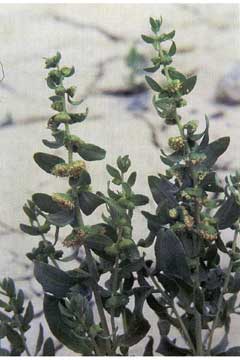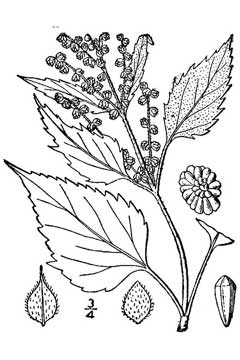 |
|
Joe F. Duft @ USDA-NRCS PLANTS Database / USDA NRCS. 1992. Western wetland flora: Field office guide to plant species. West Region, Sacramento. |
 |
| NRCS National Wetland Team, Fort Worth, TX. |
Translate this page:
Summary
Physical Characteristics

 Iva axillaris is a PERENNIAL growing to 0.2 m (0ft 8in). The species is hermaphrodite (has both male and female organs).
Iva axillaris is a PERENNIAL growing to 0.2 m (0ft 8in). The species is hermaphrodite (has both male and female organs).
Suitable for: light (sandy), medium (loamy) and heavy (clay) soils. Suitable pH: mildly acid, neutral and basic (mildly alkaline) soils and can grow in very alkaline soils.
It can grow in semi-shade (light woodland) or no shade. It prefers moist soil.
UK Hardiness Map
US Hardiness Map
Synonyms
Plant Habitats
Cultivated Beds;
Edible Uses
References More on Edible Uses
Medicinal Uses
Plants For A Future can not take any responsibility for any adverse effects from the use of plants. Always seek advice from a professional before using a plant medicinally.
Stomachic, antispasmodic[61].
References More on Medicinal Uses
The Bookshop: Edible Plant Books
Our Latest books on Perennial Plants For Food Forests and Permaculture Gardens in paperback or digital formats.

Edible Tropical Plants
Food Forest Plants for Hotter Conditions: 250+ Plants For Tropical Food Forests & Permaculture Gardens.
More

Edible Temperate Plants
Plants for Your Food Forest: 500 Plants for Temperate Food Forests & Permaculture Gardens.
More

More Books
PFAF have eight books available in paperback and digital formats. Browse the shop for more information.
Shop Now
Other Uses
References More on Other Uses
Cultivation details
References Carbon Farming Information and Carbon Sequestration Information
Temperature Converter
Type a value in the Celsius field to convert the value to Fahrenheit:
Fahrenheit:
The PFAF Bookshop
Plants For A Future have a number of books available in paperback and digital form. Book titles include Edible Plants, Edible Perennials, Edible Trees,Edible Shrubs, Woodland Gardening, and Temperate Food Forest Plants. Our new book is Food Forest Plants For Hotter Conditions (Tropical and Sub-Tropical).
Shop Now
Plant Propagation
Seed -
Other Names
If available other names are mentioned here
Native Plant Search
Search over 900 plants ideal for food forests and permaculture gardens. Filter to search native plants to your area. The plants selected are the plants in our book 'Plants For Your Food Forest: 500 Plants for Temperate Food Forests and Permaculture Gardens, as well as plants chosen for our forthcoming related books for Tropical/Hot Wet Climates and Mediterranean/Hot Dry Climates. Native Plant Search
Found In
Countries where the plant has been found are listed here if the information is available
Weed Potential
Right plant wrong place. We are currently updating this section.
Please note that a plant may be invasive in one area but may not in your area so it’s worth checking.
Conservation Status
IUCN Red List of Threatened Plants Status :

| Related Plants
|
| Latin Name | Common Name | Habit | Height | Hardiness | Growth | Soil | Shade | Moisture | Edible | Medicinal | Other |
| Adenophora divaricata | | Perennial | 1.0 |
-
| | LM | N | M | 2 | 0 | |
| Adonis aestivalis | Pheasant's Eye, Summer pheasant's eye | Annual | 0.3 |
5-9
| | LMH | SN | M | 0 | 1 | |
| Ajuga iva | Herb Ivy | Perennial | 0.0 |
-
| | LMH | SN | M | 0 | 1 | |
| Allium sativum | Garlic, Cultivated garlic | Bulb | 0.6 |
7-10
| | LM | N | DM | 5 | 5 | 4 |
| Angelica decursiva | | Perennial | 1.5 |
-
| | LMH | SN | M | 2 | 2 | |
| Asclepias sullivantii | Prairie milkweed | Perennial | 1.2 |
0-0
| | L | SN | DM | 0 | 0 | 3 |
| Avena sativa | Oats, Common oat | Annual | 0.9 |
0-0
| | LMH | N | DM | 3 | 3 | 4 |
| Camelina sativa | Gold Of Pleasure | Annual | 0.6 |
6-9
| | LMH | SN | DM | 3 | 0 | 2 |
| Cannabis sativa | Hemp, Marijuana | Annual | 2.5 |
8-11
| | LMH | N | M | 4 | 4 | 4 |
| Carpesium divaricatum | | Perennial | 1.0 |
-
| | LMH | SN | M | 1 | 2 | |
| Castanea sativa | Sweet Chestnut, European chestnut | Tree | 30.0 |
5-7
| M | LMH | N | DM | 5 | 2 | 5 |
| Cotoneaster divaricatus | Spreading Cotoneaster | Shrub | 2.0 |
4-8
| F | LMH | SN | DM | 0 | 0 | 3 |
| Crataegus aestivalis | Eastern Mayhaw, May hawthorn, Mayhaw, Apple Hawthorn | Shrub | 9.0 |
6-11
| M | LMH | SN | MWe | 3 | 2 | 5 |
| Crataegus festiva | | Shrub | 3.0 |
6-9
| | LMH | SN | MWe | 5 | 2 | 2 |
| Eleutherococcus divaricatus | | Shrub | 3.5 |
5-9
| | LMH | SN | M | 2 | 0 | |
| Eruca vesicaria sativa | Rocket | Annual | 0.6 |
6-9
| F | LMH | SN | DM | 4 | 1 | 2 |
| Eurybia divaricata | White wood aster | Perennial | 0.9 |
4-8
| F | LMH | FSN | DM | 2 | 0 | 2 |
| Galanthus nivalis | Snowdrop, Common Snowdrop | Bulb | 0.2 |
3-9
| M | MH | S | M | 0 | 1 | |
| Geum rivale | Water Avens, Purple avens | Perennial | 0.3 |
3-7
| | LMH | SN | MWe | 3 | 2 | 1 |
| Glycyrrhiza glabra | Liquorice, Cultivated licorice | Perennial | 1.2 |
7-10
| | LM | SN | M | 4 | 4 | 4 |
| Hosta tardiva | Nankai-Giboshi | Perennial | 0.5 |
-
| | LMH | SN | DM | 2 | 0 | |
| Iva xanthifolia | Giant Sumpweed | Annual | 1.0 |
0-0
| | LMH | SN | M | 0 | 1 | 1 |
| Lactuca sativa | Lettuce, Garden lettuce | Annual/Biennial | 0.9 |
5-9
| | LM | SN | M | 3 | 3 | 1 |
| Lactuca sativa angustana | Celtuce | Annual/Biennial | 0.6 |
5-9
| | LM | SN | M | 3 | 3 | 2 |
| Lactuca sativa capitata | Cabbage Lettuce | Annual/Biennial | 0.9 |
5-9
| | LM | SN | M | 3 | 3 | 2 |
| Lactuca sativa crispa | Cutting Lettuce | Annual/Biennial | 0.9 |
5-9
| | LM | SN | M | 3 | 3 | 2 |
| Lactuca sativa longifolia | Cos Lettuce | Annual/Biennial | 0.9 |
5-9
| | LM | SN | M | 3 | 3 | 2 |
| Lewisia rediviva | Bitter-Root | Perennial | 0.1 |
4-8
| | LM | N | M | 2 | 2 | |
| Madia sativa | Chile Tarweed, Coast tarweed | Annual | 0.8 |
0-0
| | LMH | N | M | 3 | 0 | 2 |
|
|
Growth: S = slow M = medium F = fast. Soil: L = light (sandy) M = medium H = heavy (clay). pH: A = acid N = neutral B = basic (alkaline). Shade: F = full shade S = semi-shade N = no shade. Moisture: D = dry M = Moist We = wet Wa = water.

Expert comment
Author
Pursh.
Botanical References
60
Links / References
For a list of references used on this page please go here
Readers comment
| Add a comment |
|
If you have important information about this plant that may help other users please add a comment or link below. Only comments or links that are felt to be directly relevant to a plant will be included. If you think a comment/link or information contained on this page is inaccurate or misleading we would welcome your feedback at [email protected]. If you have questions about a plant please use the Forum on this website as we do not have the resources to answer questions ourselves.
* Please note: the comments by website users are not necessarily those held by PFAF and may give misleading or inaccurate information.
To leave a comment please Register or login here All comments need to be approved so will not appear immediately.
|
|